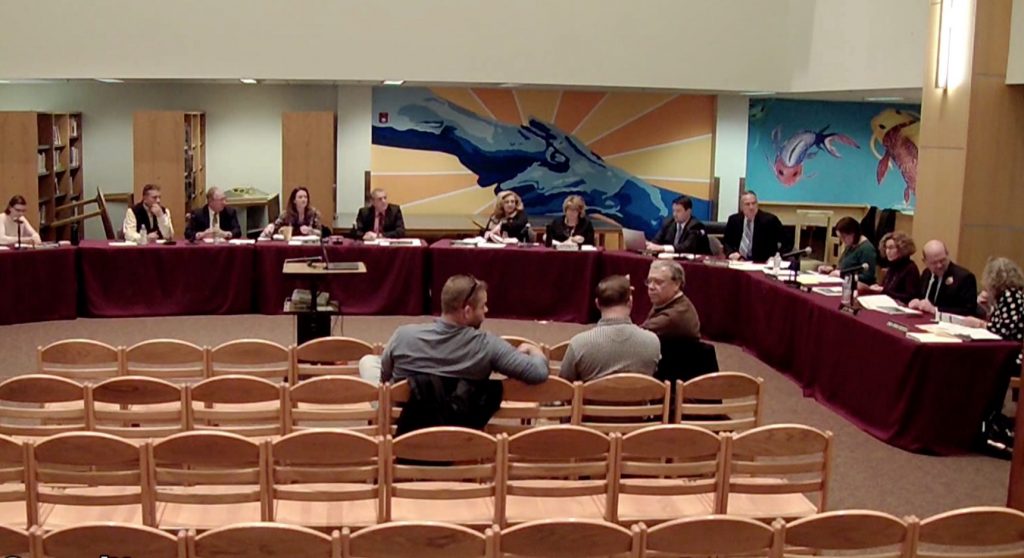 Dale Gienapp, of Gienapp Associates, provided the School Committee with its first official update on the Elementary Enrollment and Space Study at the November 7 School Committee Meeting. Gienapp shared that the study, which was approved last November, is now at a point where 8 “schemes” can be explored by the committee and by the community. The study shows that while there is only a modest six percent projected increase in Reading’s elementary population over the next ten years, increased program needs and Massachusetts School Building Administration (MSBA) guidelines have created a situation where four of the five elementary schools in town are already at or beyond capacity. In addition, it is expected that the RISE pre-school, currently housed at Reading Memorial High School (RMHS) and at Wood End Elementary School, will also grow by sixty-five students during the same time period, creating the need for at least three new classrooms to accommodate them.
Dale Gienapp, of Gienapp Associates, provided the School Committee with its first official update on the Elementary Enrollment and Space Study at the November 7 School Committee Meeting. Gienapp shared that the study, which was approved last November, is now at a point where 8 “schemes” can be explored by the committee and by the community. The study shows that while there is only a modest six percent projected increase in Reading’s elementary population over the next ten years, increased program needs and Massachusetts School Building Administration (MSBA) guidelines have created a situation where four of the five elementary schools in town are already at or beyond capacity. In addition, it is expected that the RISE pre-school, currently housed at Reading Memorial High School (RMHS) and at Wood End Elementary School, will also grow by sixty-five students during the same time period, creating the need for at least three new classrooms to accommodate them.
Elementary Schools Master Planning Report
While the district has dealt with increased space needs over the last several years through the installation of modular classrooms at three of the schools, and is currently requesting modulars at a fourth school, this is not considered a good long-term option. Gienapp assumed that in creating possible schemes for solutions, no option was “off the table,” enrollment projections are accurate, full-day kindergarten will be a reality at some point in the future, pre-school enrollment will reach 175 students and, structurally, none of the schools would be able to handle a second floor. It was also assumed that the middle schools cannot be expanded to absorb grade five students, as both schools would need to add not only classrooms but core facilities, such as gymnasium and library space. Gienapp also noted that estimated prices for the schemes are in 2019 dollars, and costs may vary in the future. He then presented the eight potential schemes.
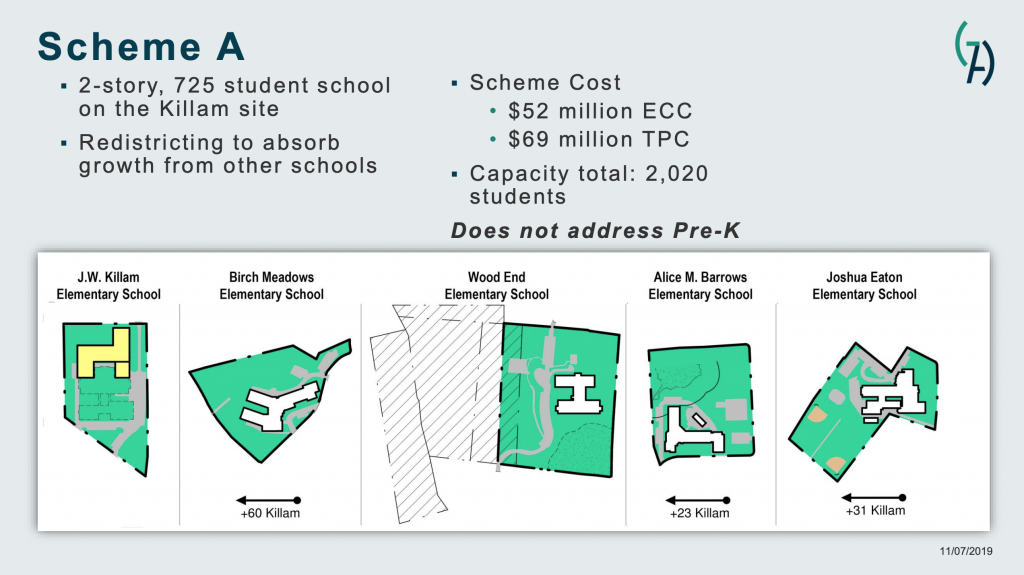 Scheme A proposes a cost of $68.7 million and would demolish Killam Elementary School in favor of a new two-story 625 student school. Redistricting would then occur to alleviate pressure on the other schools and some students would need to be bussed to Killam. This scheme would create an elementary capacity of 2,024 students while keeping RISE at RMHS and Wood End, with a few pre-school classes at the new Killam.
Scheme A proposes a cost of $68.7 million and would demolish Killam Elementary School in favor of a new two-story 625 student school. Redistricting would then occur to alleviate pressure on the other schools and some students would need to be bussed to Killam. This scheme would create an elementary capacity of 2,024 students while keeping RISE at RMHS and Wood End, with a few pre-school classes at the new Killam.
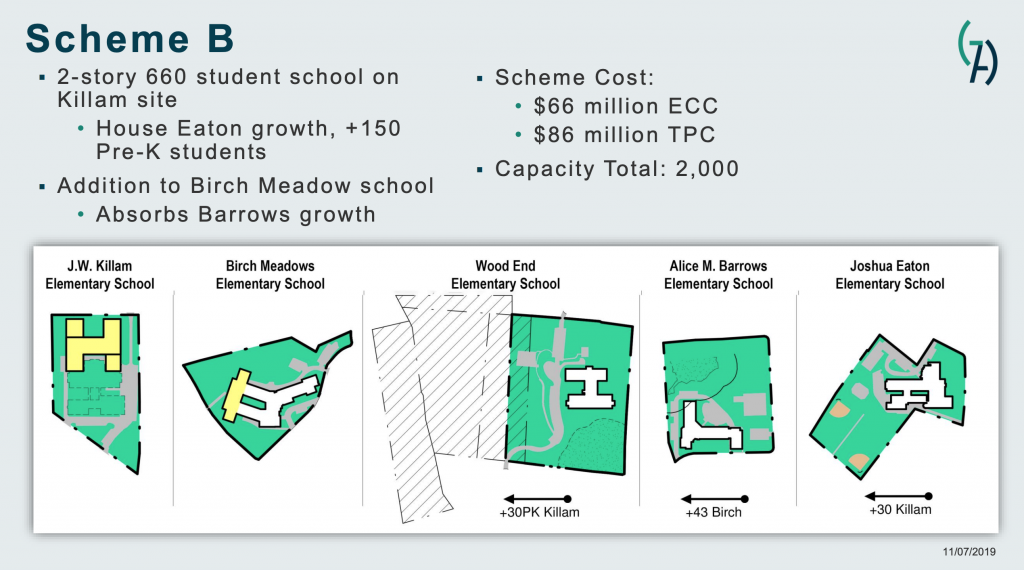 Scheme B proposes a cost of $85.8 million and would demolish Killam in favor of a new two-story 660 student school, which would include all of RISE. Birch Meadow Elementary School would receive a 20,000 square foot addition. This scheme would create an elementary capacity of 2,008 students. If RISE were to remain at RMHS, then elementary capacity would be 2108. Some redistricting and bussing would be needed as well.
Scheme B proposes a cost of $85.8 million and would demolish Killam in favor of a new two-story 660 student school, which would include all of RISE. Birch Meadow Elementary School would receive a 20,000 square foot addition. This scheme would create an elementary capacity of 2,008 students. If RISE were to remain at RMHS, then elementary capacity would be 2108. Some redistricting and bussing would be needed as well.
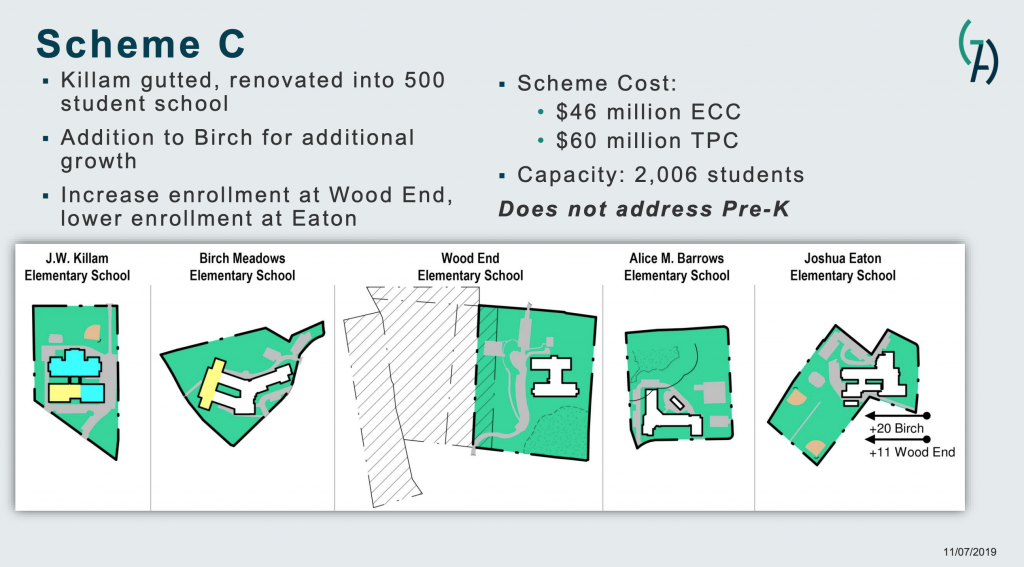 Scheme C proposes a cost of $59.8 million and would gut and renovate Killam into a 500 student school, a small portion of the school would be demolished and replaced with a two-story addition. Birch Meadow would receive a 20,000 square foot addition as well. The elementary capacity of the district under this scheme would be 2,006 with pre-school classes remaining at RMHS and Wood End, with a few at Killam. Students currently at Killam would likely have to be relocated during the construction. Some redistricting and bussing would be needed in this scheme.
Scheme C proposes a cost of $59.8 million and would gut and renovate Killam into a 500 student school, a small portion of the school would be demolished and replaced with a two-story addition. Birch Meadow would receive a 20,000 square foot addition as well. The elementary capacity of the district under this scheme would be 2,006 with pre-school classes remaining at RMHS and Wood End, with a few at Killam. Students currently at Killam would likely have to be relocated during the construction. Some redistricting and bussing would be needed in this scheme.
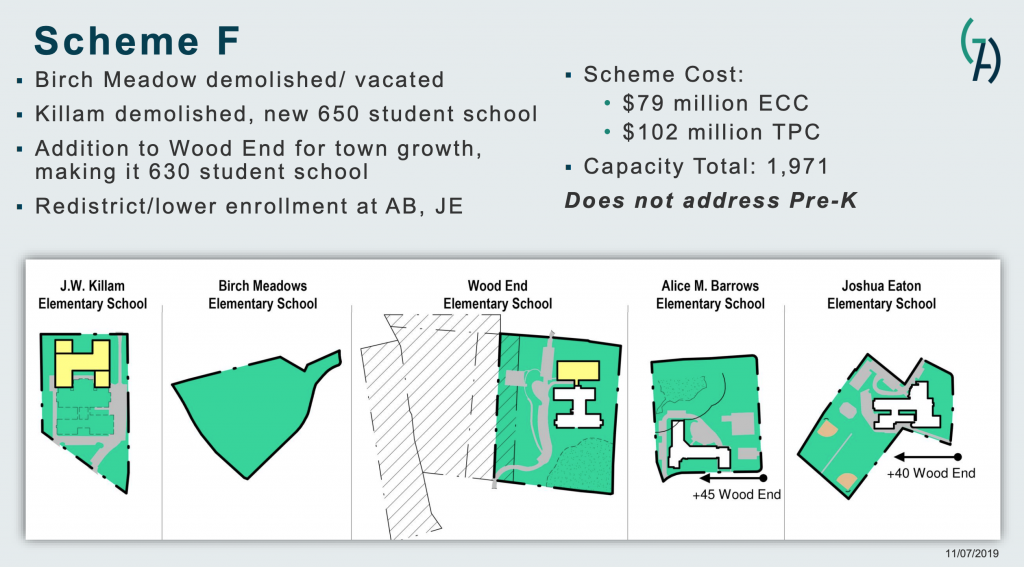 Scheme F proposes a cost of $102.7 million and would see Birch Meadow demolished or vacated. Killam would also be demolished and replaced with a 650 student school. Wood End would receive an addition to become a 630 student school. With this scheme, the elementary capacity of the district would be 1,971 students. This scheme would create approximately $90,000 in savings in staff needs annually. There would be a medium redistricting and bussing impact, with increased traffic issues at Wood End.
Scheme F proposes a cost of $102.7 million and would see Birch Meadow demolished or vacated. Killam would also be demolished and replaced with a 650 student school. Wood End would receive an addition to become a 630 student school. With this scheme, the elementary capacity of the district would be 1,971 students. This scheme would create approximately $90,000 in savings in staff needs annually. There would be a medium redistricting and bussing impact, with increased traffic issues at Wood End.
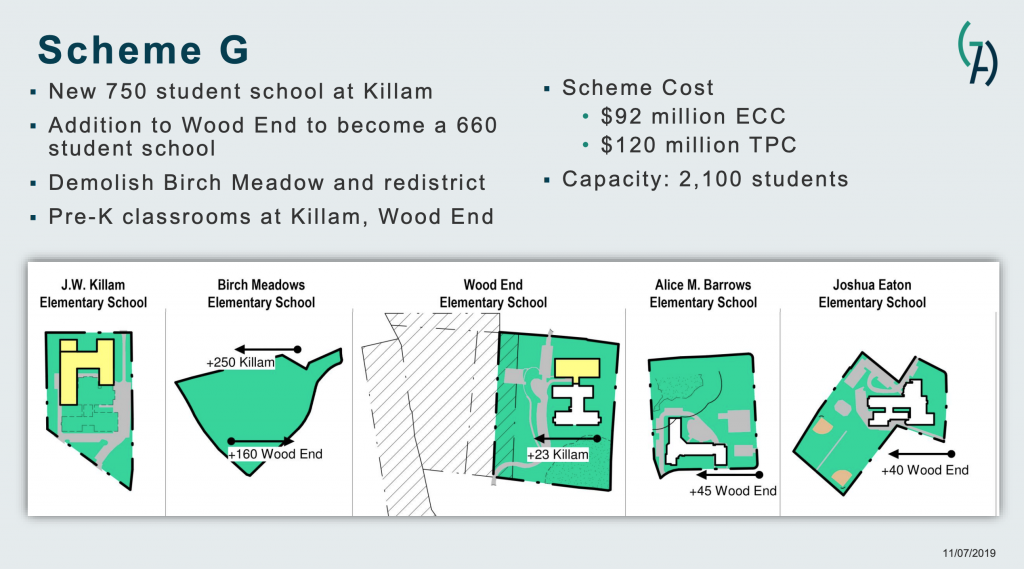 Scheme G proposes a cost of $120 million. Birch Meadow would be vacated or demolished. Killam would be replaced with a 750 student school and Wood End would receive an addition and became a 660 student school. This scheme would create an elementary capacity of 2,101 students with all pre-K classes being housed at the new Killam, freeing up space at RMHS. This scheme would create approximately $90,000 in savings in staff needs annually with significant redistricting and bussing needed.
Scheme G proposes a cost of $120 million. Birch Meadow would be vacated or demolished. Killam would be replaced with a 750 student school and Wood End would receive an addition and became a 660 student school. This scheme would create an elementary capacity of 2,101 students with all pre-K classes being housed at the new Killam, freeing up space at RMHS. This scheme would create approximately $90,000 in savings in staff needs annually with significant redistricting and bussing needed.
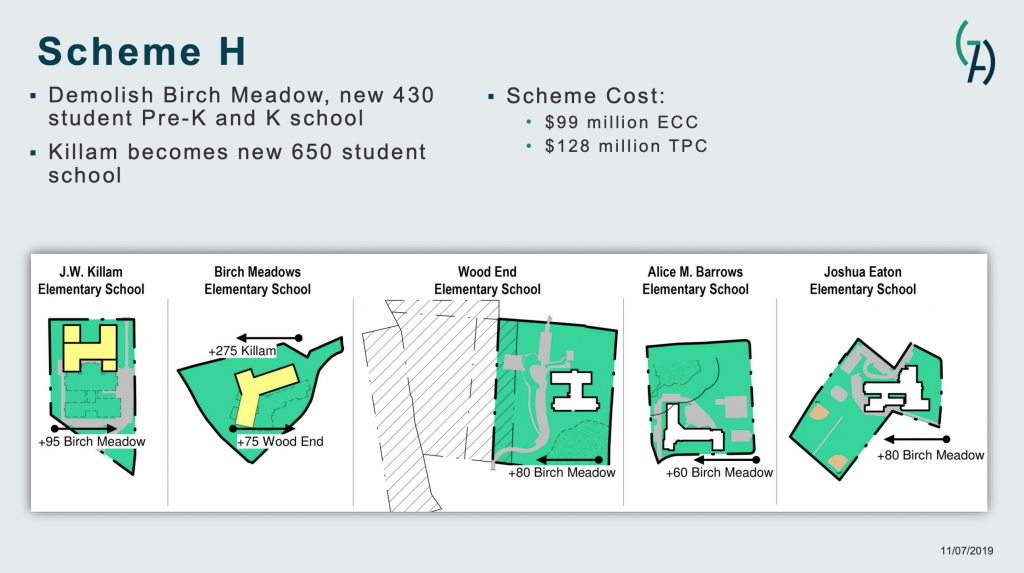 Scheme H proposes a cost of $128.7 million. Birch Meadow would be demolished and a new 430 student pre-K and kindergarten school would replace it. The remaining elementary schools would become grades one through five schools. Elementary capacity would be 2,081 students and space at RMHS would be freed up. There would be little to no new staffing needed in this scheme. There would be a high redistricting impact and most kindergarten students would need to be bussed. During construction, Birch Meadow students would need to be relocated.
Scheme H proposes a cost of $128.7 million. Birch Meadow would be demolished and a new 430 student pre-K and kindergarten school would replace it. The remaining elementary schools would become grades one through five schools. Elementary capacity would be 2,081 students and space at RMHS would be freed up. There would be little to no new staffing needed in this scheme. There would be a high redistricting impact and most kindergarten students would need to be bussed. During construction, Birch Meadow students would need to be relocated.
Gienapp noted that Killam is involved in many of the schemes. While it is structurally sound and in good condition, Killam has had no major upgrade since its construction fifty years ago. As a result, Killam has system issues that need to be addressed such as ADA accessibility, window replacement, fire suppression, and lead in the water. Additionally, the Killam and Birch Meadow districts are where most of the anticipated enrollment growth is expected to occur over the next ten years. Also, Killam is the only school on the east side of the town and is a good site for redevelopment as students could still attend classes if a new building is built behind the current building.
When questioned by School Committee member Jeanne Borawski, Gienapp shared that 650 students are generally considered to be the maximum preferred school size for an elementary school. It was also noted that a vacated Birch Meadow building, as shown in schemes F and G could be used by the town for some other purpose if desired. Gienapp concluded by indicating that the process of design, planning, and construction of a new facility if everything works perfectly, is likely to take three and a half to four years before a new school will be ready to use.
The School Committee, as a next step in the process, will be hosting a series of public hearings in order to receive community input on the various plans before making any recommendations regarding preference in the scheme.
Packet from School Committee Meeting
After an hour and thirteen-minute executive session, the School Committee returned to regular session and voted 6-0 to raise the superintendent’s salary to $187,650, which is a two and a half percent increase. School Committee chair Chuck Robinson stated that it was the committee’s intention to place $200,000 in next year’s budget for the superintendent’s salary, which Doherty would receive if he is favorably reviewed this coming June.
The School Committee adjourned at 10:25 pm.
